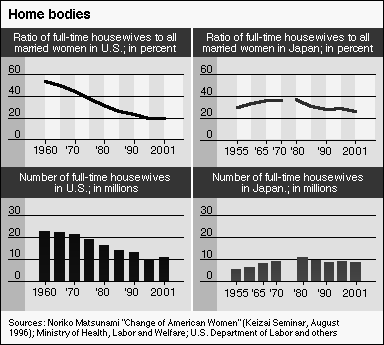Full-time Housewife: A Modern Invention
Yutaka HARADA (Chief Economist, Daiwa Institute of Research Ltd.)
Japan's population is shrinking. Its labor force has also been declining, beginning with the long stagnation of the 1990s. In the future, women's labor will be crucial to support the aging Japanese society. But participation of Japanese women in the work force is low compared with other developed countries, especially women in their late 20s to mid-30s, the age when they are busiest raising children.
Some assert that the low labor participation rate of Japanese women is due to a cultural tradition of full-time homemakers, but this is not a Japanese tradition. A hundred years ago most Japanese were farmers, and farm women were certainly not full-time housewives - they also had to do farm work, cultivating the land, planting and harvesting. Otherwise, they could not feed themselves and their families. They also had to bear the children, bring them up, and take care of home and husband.
So how did the full-time housewife come about? Economic development and industrialization in the early years of the 20th century created a lot of white-collar and skilled jobs, mostly for men, but early-stage capitalist development does not produce such male positions. Early development tends to produce jobs for women, such as in the textiles and apparel industries. But starting in the 1920s, the development of heavy industries such as steel, metal products and shipbuilding, and demand for white collar workers at big organizations, produced high-salary jobs for male workers in Japan. Since they could earn more than their family could live on, their wives did not have to work outside the home to help feed their families. This is when the full-time housewife was born.
Husbands of full-time housewives were created first, and after that full-time housewives appeared, not vice versa.
This is also true in Europe and the U.S. If we look closely at pictures like "The Reapers" and "The Angelus (The Evening Bell)" by Jean-Francois Millet, the celebrated French Barbizon painter and etcher of the mid-1800s, we can clearly see that French farm women were not full-time housewives. They worked in the fields.

In the U.S., the situation was different. There, even farmers were rich enough to support full-time housewives. After the end of World War II, the U.S. enjoyed unprecedented prosperity, and full-time housewives became the norm. In Japan's high-growth era of the 1950s and '60s, the number of full-time housewives increased, because all that growth brought plenty of high-paying jobs for their husbands.
The Japanese full-time housewives were not traditional at all. They might be an imitation of the American way of life. From the end of World War II to the 1960s, Japan was most affected by American culture. And at that time, the U.S. was the land of the full-time housewife. Japan was still poor, and the U.S. was like a dream country. Poor Japanese boys and girls saw American housewives as a symbol of an inconceivably wealthy country, and they worked hard to achieve that level of prosperity.
So we misunderstand the tradition. Japanese housewives are not traditional, but the result of the response of people to changing economic conditions. Japanese women and their families will respond to changes in the future, that is, the impending labor shortage in the aging society. Probably, we will not have to worry about labor shortages in the future.
(Originally appeared in the November 1, 2004 issue of The Nikkei Weekly, reproduced here with permission.)
|





